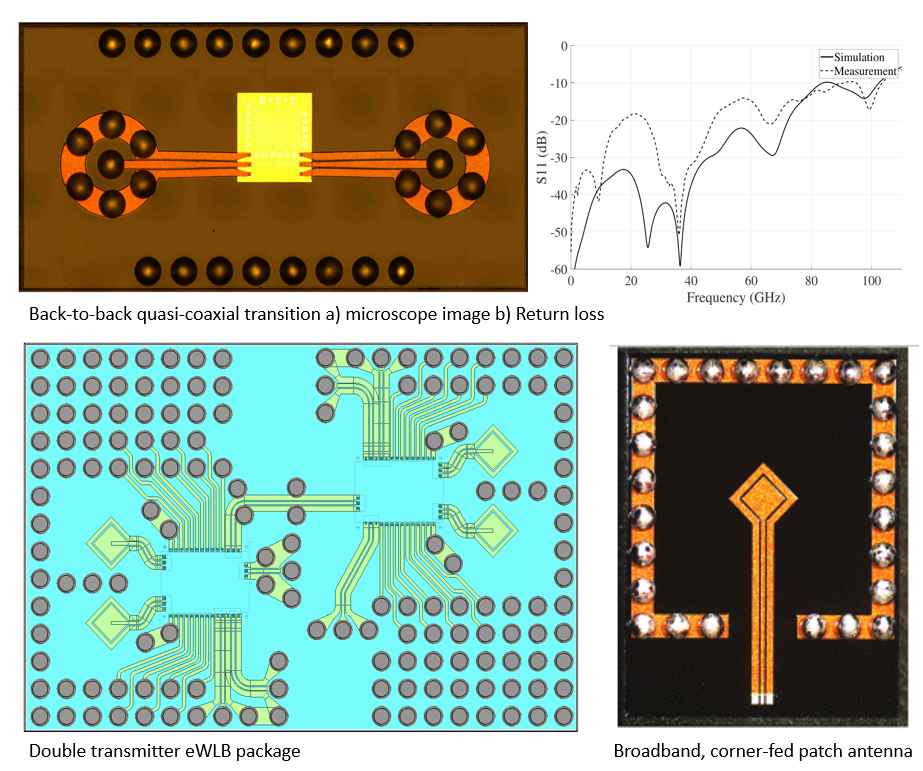REGGAE
- Funding:
BMBF
- Project partner:
Dresden University of Technology
Friedrich–Alexander University Erlangen–Nürnberg
Global Foundries
Infineon
Diamler
Siemens
Audi
InnoSenT GmbH
- Start:
October 2019
- End:
June 2024
- Contact:
Radar systems at 140 GHz in 22 nm FDSOI CMOS for accurate gesture detection with compact dimensions, high energy efficiency and digital signal generation (REGGAE)
The REGGAE project targets to revolutionise radar-based, contactless gesture recognition. The scientific contributions made with this project will result in innovations in human-machine interfaces in various fields, including automotive engineering, personal medicine, sensor networks for smart buildings, augmented reality and robotics.
The IHE was responsible for research in the areas of antennas, packaging technology, the system design and signal processing.The research conducted in the REGGAE project addresses several challenges in state-of-the-art radar system technology for gesture recognition. The radar operates at a center frequency of 140 GHz, with a 12.5 GHz bandwidth, thus leading to a miniaturized package and a high resolution. The radar uses PMCW waveforms - this improves robustness, reduces power consumption, is well-suited for MIMO arrays and high-quality resonators and noise-reducing PLLs can be used. eWLB low-loss chip packaging minimizes loss and dimensions.
A system-in-package for the wideband digital radar, in D-band, required broadband, high-gain antennas combined with broadband chip-to-package and package-to-printed circuit board (PCB) interconnects. A wideband, low-loss quasi-coaxial signal transition, and a novel electric split ring resonator (eSRR)-based antenna-in-package (AiP) with a modified reflector concept, for improved gain, in embedded wafer level ball grid array (eWLB) technology was demonstrated. A complete chip-to-package-to-PCB interconnect was also demonstrated by combining the quasi-coaxial transition with a chip-to-package interconnect. The quasi-coaxial signal transition has the largest impedance bandwidth among ball grid array-based quasi-coaxial signal transitions. For the modified reflector concept, a horn-shaped cavity is micromachined in the PCB substrate and remetallized with aerosol-jet printing, placing the reflector 0.25λ from the antenna. The antenna gain is improved with up to 5.3 dB. The AiP with the horn-shaped reflector is the single element with the highest gain, in eWLB technology, above 100 GHz.
T. Antes, E. Bekker, A. Bhutani, and T. Zwick,
“A Flexible Data Set for Radar-based Gesture Recognition with an FC-FMCW Radar,”
https://doi.org/10.35097/hCNNxXlJBdFTSYse
Publications
Journals
- E. Bekker, G. Gramlich, L. Valenziano, L.G. de Oliveira, T. Zwick and A. Bhutani, "Broadband packaging solution in embedded wafer level ball grid array technology for D-band PMCW radar," International Journal of Microwave and Wireless Technologies. Published online 2024:1-12. doi:10.1017/S1759078724000266. [Available Online]
-
L. G. de Oliveira, T. Antes, B. Nuss, E. Bekker, A. Bhutani, A. Diewald, M. B. Alabd, Y. Li, M. Pauli and T. Zwick, "Doppler Shift Tolerance of Typical Pseudorandom Binary Sequences in PMCW Radar," in Sensors, vol. 32, no. 3, pp. 257-260, March 2022, doi: 10.1109/LMWC.2021.3123691. [Available Online]
-
L. G. de Oliveira, E. Bekker, A. Bhutani, A. Diewald, B. Nuss, T. Antes and T. Zwick, "Doppler Shift Tolerance of Accumulation and Outer Coding in MIMO-PMCW Radar," in IEEE Microwave and Wireless Components Letters, vol. 22, no. 9, pp. 1-21, April 2022, doi: 10.1109/LMWC.2021.3123691. [Available Online]
-
L. Giroto de Oliveira, B. Nuss, M. B. Alabd, A. Diewald, M. Pauli and T. Zwick, "Joint Radar-Communication Systems: Modulation Schemes and System Design," in IEEE Transactions on Microwave Theory and Techniques, vol. 70, no. 3, pp. 1521-1551, March 2022, doi: 10.1109/TMTT.2021.3126887. [Available Online]
Conference Proceedings
- T. Antes, L. G. De Oliveira, A. Diewald, E. Bekker, A. Bhutani and T. Zwick, "Velocities in Human Hand Gestures for Radar-based Gesture Recognition Applications," 2023 IEEE Radar Conference (RadarConf23), San Antonio, TX, USA, 2023, pp. 1-5, doi: 10.1109 RadarConf2351548.2023.10149720. [Available Online]
- L. G. de Oliveira et al., "Enabling Joint Radar-Communication Operation in Shift Register-Based PMCW Radars," 2023 20th European Radar Conference (EuRAD), Berlin, Germany, 2023, pp. 85-88, doi: 10.23919/EuRAD58043.2023.10289516. [Available Online]
-
T. Antes, L. G. de Oliveira, E. Bekker, A. Bhutani and T. Zwick, "Doppler Robustness Analysis of Orthogonal Sequences for MIMO PMCW Radar," 2022 23rd International Radar Symposium (IRS), Gdansk, Poland, 2022, pp. 384-389, doi: 10.23919/IRS54158.2022.9904975. [Available Online]
-
E. Bekker, A. Bhutani, L. G. de Oliveira, T. Antes and T. Zwick, "Differential Split-Ring Resonator-Based Antenna at 140 GHz in Embedded Wafer Level Ball Grid Array Technology," 2022 52nd European Microwave Conference (EuMC), Milan, Italy, 2022, pp. 528-531, doi: 10.23919/EuMC54642.2022.9924286. [Available Online]
-
E. Bekker, A. Bhutani, L. G. de Oliveira, T. Antes and T. Zwick, "Broadband Split Ring Resonator-Based Antennas at 140 GHz in Embedded Wafer Level Ball Grid Array Technology," 2022 International Workshop on Antenna Technology (iWAT), Dublin, Ireland, 2022, pp. 60-63, doi: 10.1109/iWAT54881.2022.9811051. [Available Online]
-
A. Bhutani, E. Bekker, T. Li, L. G. de Oliveira and T. Zwick, "140 GHz Differential Antennas in Embedded Wafer Level Ball Grid Array Technology," 2021 51st European Microwave Conference (EuMC), London, United Kingdom, 2022, pp. 881-884, doi: 10.23919/EuMC50147.2022.9784312. [Available Online]
-
A. Bhutani, E. Bekker, L. G. de Oliveira, M. Pauli and T. Zwick, "140 GHz Broadband Antenna in Embedded Wafer-Level Ball Grid Array Technology," 2021 15th European Conference on Antennas and Propagation (EuCAP), Dusseldorf, Germany, 2021, pp. 1-5, doi: 10.23919/EuCAP51087.2021.9411122. [Available Online]

